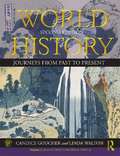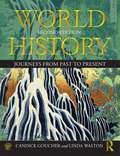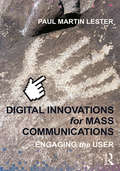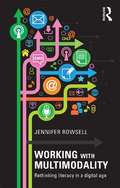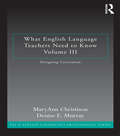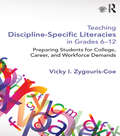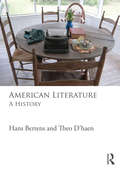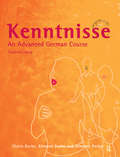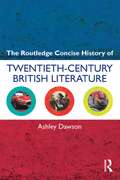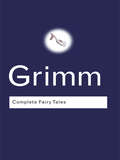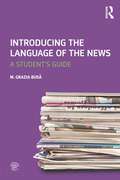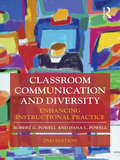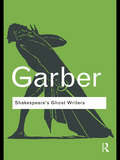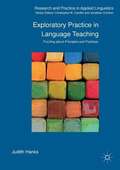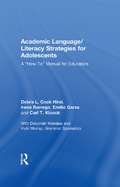- Table View
- List View
World History: From Human Origins to 1500 CE
by Candice Goucher Linda WaltonWorld History: Journeys from Past to Present uses common themes to present an integrated and comprehensive survey of human history from its origins to the present day. By weaving together thematic and regional perspectives in coherent chronological narratives, Goucher and Walton transform the overwhelming sweep of the human past into a truly global story that is relevant to the contemporary issues of our time. Revised and updated throughout, the second edition of this innovative textbook combines clear chronological progression with thematically focused chapters. In this volume, chapters are divided into three parts as follows: PART 1. EMERGENCE (Human origins to 500 CE) PART 2. ORDER (1 CE-1500 CE) PART 3. CONNECTIONS (500-1600 CE) The expanded new edition features an impressive full-color design with a host of illustrations, maps and primary source excerpts integrated throughout. Chapter opening timelines supply context for the material ahead, while end of chapter questions and annotated additional resources provide students with the tools for independent study. Each chapter and part boasts introductory and summary essays that guide the reader in comprehending the relevant theme. In addition, the companion website offers a range of resources including an interactive historical timeline, an indispensable study skills section for students, tips for teaching and learning thematically, and PowerPoint slides, lecture material and discussion questions in a password protected area for instructors. This textbook provides a basic introduction for all students of World History, incorporating thematic perspectives that encourage critical thinking, link to globally relevant contemporary issues, and stimulate further study.
World History: Journeys from Past to Present
by Candice Goucher Linda WaltonWorld History: Journeys from Past to Present uses common themes to present an integrated and comprehensive survey of human history from its origins to the present day. By weaving together thematic and regional perspectives in coherent chronological narratives, Goucher and Walton transform the overwhelming sweep of the human past into a truly global story that is relevant to the contemporary issues of our time. Revised and updated throughout, the second edition of this innovative textbook combines clear chronological progression with thematically focused chapters divided into six parts as follows: PART 1. EMERGENCE (Human origins to 500 CE) PART 2. ORDER (1 CE-1500 CE) PART 3. CONNECTIONS (500-1600 CE) PART 4. BRIDGING WORLDS (1300-1800 CE) PART 5. TRANSFORMING LIVES (1500-1900) PART 6. FORGING A GLOBAL COMMUNITY (1800- Present) The expanded new edition features an impressive full-color design with a host of illustrations, maps and primary source excerpts integrated throughout. Chapter opening timelines supply context for the material ahead, while end of chapter questions and annotated additional resources provide students with the tools for independent study. Each chapter and part boasts introductory and summary essays that guide the reader in comprehending the relevant theme. In addition, the companion website offers a range of resources including an interactive historical timeline, an indispensable study skills section for students, tips for teaching and learning thematically, and PowerPoint slides, lecture material and discussion questions in a password protected area for instructors. This textbook provides a basic introduction for all students of World History, incorporating thematic perspectives that encourage critical thinking, link to globally relevant contemporary issues, and stimulate further study.
World History: Journeys from Past to Present
by Candice Goucher Linda WaltonWorld History: Journeys from Past to Present uses common themes to present an integrated and comprehensive survey of human history from its origins to the present day. By weaving together thematic and regional perspectives in coherent chronological narratives, Goucher and Walton transform the overwhelming sweep of the human past into a truly global story that is relevant to the contemporary issues of our time. Revised and updated throughout, the second edition of this innovative textbook combines clear chronological progression with thematically focused chapters divided into six parts as follows: PART 1. EMERGENCE (Human origins to 500 CE) PART 2. ORDER (1 CE-1500 CE) PART 3. CONNECTIONS (500-1600 CE) PART 4. BRIDGING WORLDS (1300-1800 CE) PART 5. TRANSFORMING LIVES (1500-1900) PART 6. FORGING A GLOBAL COMMUNITY (1800- Present) The expanded new edition features an impressive full-color design with a host of illustrations, maps and primary source excerpts integrated throughout. Chapter opening timelines supply context for the material ahead, while end of chapter questions and annotated additional resources provide students with the tools for independent study. Each chapter and part boasts introductory and summary essays that guide the reader in comprehending the relevant theme. In addition, the companion website offers a range of resources including an interactive historical timeline, an indispensable study skills section for students, tips for teaching and learning thematically, and PowerPoint slides, lecture material and discussion questions in a password protected area for instructors. This textbook provides a basic introduction for all students of World History, incorporating thematic perspectives that encourage critical thinking, link to globally relevant contemporary issues, and stimulate further study.
Digital Innovations for Mass Communications: Engaging the User
by Paul Martin LesterIn every field of mass communications—advertising, entertainment studies, journalism, public relations, radio-television-film, tourism, and visual reporting—professionals understand the importance of storytelling. Regardless of whether the finished product is a commercial, an in-depth investigative piece, a public service campaign, an independent documentary, a travelogue, or a collection of photographs, effective storytelling requires a combination of creativity, empathy, and expertise. Through the innovative technologies and techniques described in this textbook, students will learn how to turn passive readers and viewers into engaged and regular users. The sixteen chapters each include a brief introduction, assignments, simple-to-follow step-by-step exercises, and sources for additional information in which users will learn to produce apps, informational graphics, quick response codes, quizzes, simulations, smartphone and table icons, social media campaigns, three-dimensional pictures, and video. Students will work with the following programs: Blogger, Dreamweaver, Excel, Facebook, GeoCommons, Google Maps, Illustrator, Imgur, iMovie, Infogram, iShowU, JavaScript, JustGive, Kaywa, Kickstarter, LinkedIn, Onvert, Photoshop, Pixel Resort, QuickTime, Reddit, Second Life, SurveyMonkey, TheAppBuilder, Twitter, Vizualize, Wikipedia, Word, WordPress, and YouTube. When digital innovations are added to traditional print and screen presentations, a media user is not only allowed to interact with the information but can also physically engage with the story displayed. Giving students the tools they need to transform their storytelling in this manner is the ultimate goal of this textbook.
Digital Innovations for Mass Communications: Engaging the User
by Paul Martin LesterIn every field of mass communications—advertising, entertainment studies, journalism, public relations, radio-television-film, tourism, and visual reporting—professionals understand the importance of storytelling. Regardless of whether the finished product is a commercial, an in-depth investigative piece, a public service campaign, an independent documentary, a travelogue, or a collection of photographs, effective storytelling requires a combination of creativity, empathy, and expertise. Through the innovative technologies and techniques described in this textbook, students will learn how to turn passive readers and viewers into engaged and regular users. The sixteen chapters each include a brief introduction, assignments, simple-to-follow step-by-step exercises, and sources for additional information in which users will learn to produce apps, informational graphics, quick response codes, quizzes, simulations, smartphone and table icons, social media campaigns, three-dimensional pictures, and video. Students will work with the following programs: Blogger, Dreamweaver, Excel, Facebook, GeoCommons, Google Maps, Illustrator, Imgur, iMovie, Infogram, iShowU, JavaScript, JustGive, Kaywa, Kickstarter, LinkedIn, Onvert, Photoshop, Pixel Resort, QuickTime, Reddit, Second Life, SurveyMonkey, TheAppBuilder, Twitter, Vizualize, Wikipedia, Word, WordPress, and YouTube. When digital innovations are added to traditional print and screen presentations, a media user is not only allowed to interact with the information but can also physically engage with the story displayed. Giving students the tools they need to transform their storytelling in this manner is the ultimate goal of this textbook.
Working with Multimodality: Rethinking Literacy in a Digital Age
by Jennifer RowsellIn today’s digital world, we have multiple modes of meaning-making: sounds, images, hypertexts. Yet, within literacy education, even ‘new’ literacies, we know relatively little about how to work with and produce modally complex texts. In Working with Multimodality, Jennifer Rowsell focuses on eight modes: words, images, sounds, movement, animation, hypertext, design and modal learning. Throughout the book each mode is illustrated by cases studies based on the author’s interviews with thirty people, who have extensive experience working with a mode in their field. From a song writer to a well known ballet dancer, these people all discuss what it means to do multimodality well. This accessible textbook brings the multiple modes together into an integrated theory of multimodality. Step-by-step, beginning with theory then exploring modes and how to work with them, before concluding with how to apply this in an investigation, each stage of working with multimodality is covered. Working with Multimodality will help students and scholars to: • Think about specific modes and how they function • Consider the implications for multimodal meaning-making • Become familiar with conventions and folk knowledge about given modes • Apply this same knowledge to their own production of media texts in classrooms Assuming no prior knowledge about multimodality and its properties, Working with Multimodality is designed to appeal to advanced undergraduate and postgraduate students interested in how learning and innovation is different in a digital and media age and is an essential textbook for courses in literacy, new media and multimodality within applied linguistics , education and communication studies.
Working with Multimodality: Rethinking Literacy in a Digital Age
by Jennifer RowsellIn today’s digital world, we have multiple modes of meaning-making: sounds, images, hypertexts. Yet, within literacy education, even ‘new’ literacies, we know relatively little about how to work with and produce modally complex texts. In Working with Multimodality, Jennifer Rowsell focuses on eight modes: words, images, sounds, movement, animation, hypertext, design and modal learning. Throughout the book each mode is illustrated by cases studies based on the author’s interviews with thirty people, who have extensive experience working with a mode in their field. From a song writer to a well known ballet dancer, these people all discuss what it means to do multimodality well. This accessible textbook brings the multiple modes together into an integrated theory of multimodality. Step-by-step, beginning with theory then exploring modes and how to work with them, before concluding with how to apply this in an investigation, each stage of working with multimodality is covered. Working with Multimodality will help students and scholars to: • Think about specific modes and how they function • Consider the implications for multimodal meaning-making • Become familiar with conventions and folk knowledge about given modes • Apply this same knowledge to their own production of media texts in classrooms Assuming no prior knowledge about multimodality and its properties, Working with Multimodality is designed to appeal to advanced undergraduate and postgraduate students interested in how learning and innovation is different in a digital and media age and is an essential textbook for courses in literacy, new media and multimodality within applied linguistics , education and communication studies.
What English Language Teachers Need to Know Volume III: Designing Curriculum
by MaryAnn Christison Denise E. MurrayWhat English Teachers Need to Know, a set of companion texts designed for pre-service teachers and teachers new to the field of ELT, addresses the key question: What do English language teachers need to know and be able to do in order for their students to learn English? These texts work for teachers across different contexts (countries where English is the dominant language, one of the official languages, or taught as a foreign language); different levels (elementary/primary, secondary, college or university, or adult education); and different learning purposes (general English, workplace English, English for academic purposes, or English for specific purposes). Volume I, on understanding learning, provides the background information that teachers need to know and be able to use in their classroom. Volume II, on facilitating learning, covers the three main facets of teaching: planning, instructing, and assessing. Volume III, on designing curriculum, covers the contexts for, processes in, and types of ELT curricula—linguistic based, content-based, learner-centered, and learning-centered. Throughout the three volumes, the focus is on outcomes, that is, student learning. Features • Situated in current research in the field of English language teaching and other disciplines that inform it • Sample data, including classroom vignettes • Three kinds of activities/tasks: Reflect, Explore, and Expand
What English Language Teachers Need to Know Volume III: Designing Curriculum
by MaryAnn Christison Denise E. MurrayWhat English Teachers Need to Know, a set of companion texts designed for pre-service teachers and teachers new to the field of ELT, addresses the key question: What do English language teachers need to know and be able to do in order for their students to learn English? These texts work for teachers across different contexts (countries where English is the dominant language, one of the official languages, or taught as a foreign language); different levels (elementary/primary, secondary, college or university, or adult education); and different learning purposes (general English, workplace English, English for academic purposes, or English for specific purposes). Volume I, on understanding learning, provides the background information that teachers need to know and be able to use in their classroom. Volume II, on facilitating learning, covers the three main facets of teaching: planning, instructing, and assessing. Volume III, on designing curriculum, covers the contexts for, processes in, and types of ELT curricula—linguistic based, content-based, learner-centered, and learning-centered. Throughout the three volumes, the focus is on outcomes, that is, student learning. Features • Situated in current research in the field of English language teaching and other disciplines that inform it • Sample data, including classroom vignettes • Three kinds of activities/tasks: Reflect, Explore, and Expand
Teaching Discipline-Specific Literacies in Grades 6-12: Preparing Students for College, Career, and Workforce Demands
by Vicky I. Zygouris-CoeComprehensive, timely, and relevant, this text offers an approach to discipline-specific literacy instruction that is aligned with the Common Core State Standards and the needs of teachers, students, and secondary schools across the nation. It is essential that teachers know how to provide instruction that both develops content and literacy knowledge and skills, and aims at reducing student achievement gaps. Building on the research-supported premise that discipline-specific reading instruction is key to achieving these goals, this text provides practical guidance and strategies for prospective and practicing content area teachers (and other educators) on how to prepare all students to succeed in college and the workforce. Pedagogical features in each chapter engage readers in digging deeper and in applying the ideas and strategies presented in their own contexts: Classroom Life (real 6-12 classroom scenarios and interviews with content-area teachers) Common Core State Standards Connections College, Career, and Workforce Connections Applying Discipline-Specific Literacies Think Like an Expert ("habits of thinking and learning" specific to each discipline) Digital Literacies Differentiating Instruction Reflect and Apply Questions Extending Learning Activities The Companion Website includes: Lesson plan resources Annotated links to video files Annotated links to additional resources and information Glossary/Flashcards For Instructors: All images and figures used in the text provided in an easily downloadable format For Instructors: PowerPoint lecture slides
Teaching Discipline-Specific Literacies in Grades 6-12: Preparing Students for College, Career, and Workforce Demands
by Vicky I. Zygouris-CoeComprehensive, timely, and relevant, this text offers an approach to discipline-specific literacy instruction that is aligned with the Common Core State Standards and the needs of teachers, students, and secondary schools across the nation. It is essential that teachers know how to provide instruction that both develops content and literacy knowledge and skills, and aims at reducing student achievement gaps. Building on the research-supported premise that discipline-specific reading instruction is key to achieving these goals, this text provides practical guidance and strategies for prospective and practicing content area teachers (and other educators) on how to prepare all students to succeed in college and the workforce. Pedagogical features in each chapter engage readers in digging deeper and in applying the ideas and strategies presented in their own contexts: Classroom Life (real 6-12 classroom scenarios and interviews with content-area teachers) Common Core State Standards Connections College, Career, and Workforce Connections Applying Discipline-Specific Literacies Think Like an Expert ("habits of thinking and learning" specific to each discipline) Digital Literacies Differentiating Instruction Reflect and Apply Questions Extending Learning Activities The Companion Website includes: Lesson plan resources Annotated links to video files Annotated links to additional resources and information Glossary/Flashcards For Instructors: All images and figures used in the text provided in an easily downloadable format For Instructors: PowerPoint lecture slides
American Literature: A History
by Hans Bertens Theo D'haenThis comprehensive history of American Literature traces its development from the earliest colonial writings of the late 1500s through to the present day. This lively, engaging and highly accessible guide: <p><p> offers lucid discussions of all major influences and movements such as Puritanism, Transcendentalism, Realism, Naturalism, Modernism and Postmodernism <p> draws on the historical, cultural, and political contexts of key literary texts and authors <p> covers the whole range of American literature: prose, poetry, theatre and experimental literature <p> includes substantial sections on native and ethnic American literatures <p> explains and contextualises major events, terms and figures in American history. <p> This book is essential reading for anyone seeking to situate their reading of American Literature in the appropriate religious, cultural, and political contexts.
American Literature: A History
by Hans Bertens Theo D'haenThis comprehensive history of American Literature traces its development from the earliest colonial writings of the late 1500s through to the present day. This lively, engaging and highly accessible guide: <p><p> offers lucid discussions of all major influences and movements such as Puritanism, Transcendentalism, Realism, Naturalism, Modernism and Postmodernism <p> draws on the historical, cultural, and political contexts of key literary texts and authors <p> covers the whole range of American literature: prose, poetry, theatre and experimental literature <p> includes substantial sections on native and ethnic American literatures <p> explains and contextualises major events, terms and figures in American history. <p> This book is essential reading for anyone seeking to situate their reading of American Literature in the appropriate religious, cultural, and political contexts.
Kenntnisse: An Advanced German Course
by Claire S.A. Burke Edmund Burke Susanne ParkerThis topics-based textbook has been devised to meet the needs of modern courses in advanced German at undergraduate level. Features include:* focus on practical language skills, such as writing articles, preparing CVs, translating and interpreting* authentic contemporary texts and original audio material* oral language practice* grammar reinforcement.Kenntnisse can be used as core teaching material or as a supplementary text. The complete course comprises the student's book, 2x60 minute audio cassettes and a teacher's book.
The Routledge Concise History of Twentieth-Century British Literature
by Ashley DawsonIn The Routledge Concise History of Twentieth-Century British Literature Ashley Dawson identifies the key British writers and texts, shaped by era-defining cultural and historical events and movements from the period. He provides: Analysis of works by a diverse range of influential authors Examination of the cultural and literary impact of crucial historical, social, political and cultural events Discussion of Britain’s imperial status in the century and the diversification of the nation through Black and Asian British Literature Readers are also provided with a comprehensive timeline, a glossary of terms, further reading and explanatory text boxes featuring further information on key figures and events.
The Routledge Concise History of Twentieth-Century British Literature
by Ashley DawsonIn The Routledge Concise History of Twentieth-Century British Literature Ashley Dawson identifies the key British writers and texts, shaped by era-defining cultural and historical events and movements from the period. He provides: Analysis of works by a diverse range of influential authors Examination of the cultural and literary impact of crucial historical, social, political and cultural events Discussion of Britain’s imperial status in the century and the diversification of the nation through Black and Asian British Literature Readers are also provided with a comprehensive timeline, a glossary of terms, further reading and explanatory text boxes featuring further information on key figures and events.
Complete Fairy Tales (Routledge Classics)
by Jacob Grimm Wilhelm GrimmThe tale of 'Cinderella' is told wherever stories are still read aloud and everyone is familiar with 'Rapunzel' and 'The Golden Goose', but who has heard all the wonderful stories collected by the Brothers Grimm? Well, here's your chance, for within these covers you will find every one of their 210 tales, in all their enchantment and rapture, terror and wisdom, tragedy and beauty.
Introducing the Language of the News: A Student's Guide
by M. Grazia BusaIntroducing the Language of the News is a comprehensive introduction to the language of news reporting. Assuming no prior knowledge of linguistics, the book provides an accessible analysis of the processes that produce news language, and discusses how different linguistic choices promote different interpretations of news texts. Key features include: comprehensive coverage of both print and online news, including news design and layout, story structure, the role of headlines and leads, style, grammar and vocabulary a range of contemporary examples in the international press, from the 2012 Olympics, to political events in China and the Iraq War. chapter summaries, activities, sample analyses and commentaries, enabling students to undertake their own analyses of news texts a companion website with extra activities, further readings and web links. Written by an experienced researcher and teacher, this book is essential reading for students studying English language and linguistics, media and communication studies, and journalism.
Introducing the Language of the News: A Student's Guide
by M. Grazia BusaIntroducing the Language of the News is a comprehensive introduction to the language of news reporting. Assuming no prior knowledge of linguistics, the book provides an accessible analysis of the processes that produce news language, and discusses how different linguistic choices promote different interpretations of news texts. Key features include: comprehensive coverage of both print and online news, including news design and layout, story structure, the role of headlines and leads, style, grammar and vocabulary a range of contemporary examples in the international press, from the 2012 Olympics, to political events in China and the Iraq War. chapter summaries, activities, sample analyses and commentaries, enabling students to undertake their own analyses of news texts a companion website with extra activities, further readings and web links. Written by an experienced researcher and teacher, this book is essential reading for students studying English language and linguistics, media and communication studies, and journalism.
Classroom Communication and Diversity: Enhancing Instructional Practice
by Robert G. Powell Dana L. PowellClassroom Communication and Diversity is an integral resource for teaching awareness of diversity issues and communication in the classroom. Drawing on the research in the communication and education disciplines, authors Robert G. Powell and Dana Caseau provide theoretical models and useful strategies for improving instructional practices. They address the ways in which culture influences communication in the classroom, and assist teachers in developing the skills necessary to meet the needs of the students in their classrooms. New to the second edition is an expanded skills component, additional teaching resources, and an increased focus on the role of diversity in the classroom. Much of the information shared in this text derives from the authors' research and experience in schools and from the experiences of others, including teachers, parents, and children. Their experiences, combined with the cross-disciplinary approach, produce a volume of unique perspectives and considerable insight.
Classroom Communication and Diversity: Enhancing Instructional Practice
by Robert G. Powell Dana L. PowellClassroom Communication and Diversity is an integral resource for teaching awareness of diversity issues and communication in the classroom. Drawing on the research in the communication and education disciplines, authors Robert G. Powell and Dana Caseau provide theoretical models and useful strategies for improving instructional practices. They address the ways in which culture influences communication in the classroom, and assist teachers in developing the skills necessary to meet the needs of the students in their classrooms. New to the second edition is an expanded skills component, additional teaching resources, and an increased focus on the role of diversity in the classroom. Much of the information shared in this text derives from the authors' research and experience in schools and from the experiences of others, including teachers, parents, and children. Their experiences, combined with the cross-disciplinary approach, produce a volume of unique perspectives and considerable insight.
Shakespeare's Ghost Writers: Literature as Uncanny Causality
by Marjorie GarberThe plays of Shakespeare are filled with ghosts – and ghost writing. Shakespeare's Ghost Writers is an examination of the authorship controversy surrounding Shakespeare: the claim made repeatedly that the plays were ghost written. Ghosts take the form of absences, erasures, even forgeries and signatures – metaphors extended to include Shakespeare himself and his haunting of us, and in particular theorists such Derrida, Marx, Nietzsche, and Freud – the figure of Shakespeare constantly made and remade by contemporary culture. Marjorie Garber, one of the most eminent Shakespearean theorists writing today, asks what is at stake in the imputation that "Shakespeare" did not write the plays, and shows that the plays themselves both thematize and theorize that controversy. This Routledge Classics edition contains a new preface and new chapter by the author.
Exploratory Practice In English Language Teaching (PDF)
by J. HanksThis book tracks the development of Exploratory Practice since the early 1990s as an original form of practitioner research in the field of English language teaching. Drawing on case studies, vignettes and narratives from teachers and learners around the world as they experienced Exploratory Practice in their different contexts, Hanks examines the theoretical and philosophical underpinnings of the Exploratory Practice framework and asks what the principles really mean in practice. For language professionals considering investigating their classrooms and their teaching/learning practices rigorously and thoughtfully, this book breaks new ground, arguing for a fresh perspective: (exploratory) practice-as-research. Judith Hanks is Lecturer in TESOL at the University of Leeds, UK. Her work bridges specialist areas in language teacher education, intercultural communication, TESOL and EAP.
Shakespeare's Ghost Writers: Literature as Uncanny Causality
by Marjorie GarberThe plays of Shakespeare are filled with ghosts – and ghost writing. Shakespeare's Ghost Writers is an examination of the authorship controversy surrounding Shakespeare: the claim made repeatedly that the plays were ghost written. Ghosts take the form of absences, erasures, even forgeries and signatures – metaphors extended to include Shakespeare himself and his haunting of us, and in particular theorists such Derrida, Marx, Nietzsche, and Freud – the figure of Shakespeare constantly made and remade by contemporary culture. Marjorie Garber, one of the most eminent Shakespearean theorists writing today, asks what is at stake in the imputation that "Shakespeare" did not write the plays, and shows that the plays themselves both thematize and theorize that controversy. This Routledge Classics edition contains a new preface and new chapter by the author.
Academic Language/Literacy Strategies for Adolescents: A "How-To" Manual for Educators
by Debra L. Hirai Irene Borrego Emilio Garza Carl T. KloockFast-paced, practical, and innovative, this text for pre-service and in-service teachers features clear, easily accessible lessons and professional development activities to improve the delivery of academic language/literacy education across the content areas in junior/middle school and high school classrooms. Numerous hands-on tools and techniques demonstrate the effectiveness of content-area instruction for students in a wide variety of school settings, particularly English language learners, struggling readers, and other special populations of students. Based on a strong professional development model the authors have been instrumental in designing, Academic Language/Literacy Strategies for Adolescents addresses: motivation attributes of academic language vocabulary: theory and practice reading skills development grammar and writing. A wealth of charts, graphs, and lesson plans give clear examples of academic language/literacy strategies in action. The appendices – a key component of the practical applications developed in the text – include a glossary, exemplary lessons that address key content areas, and a Grammar Handbook. In this era of increased accountability, coupled with rapid demographic change and challenges to traditional curricula and pedagogical methods, educators will find this book to be a great resource.
